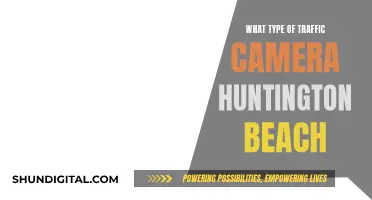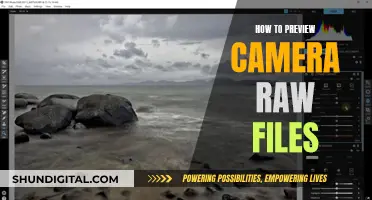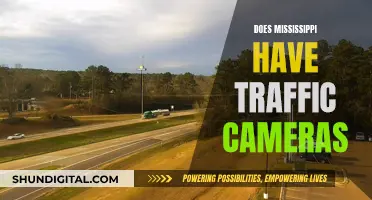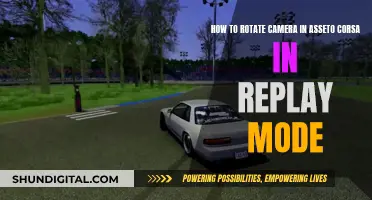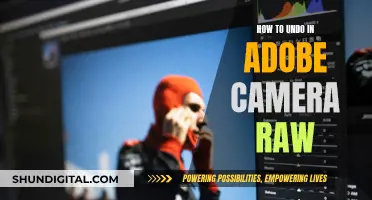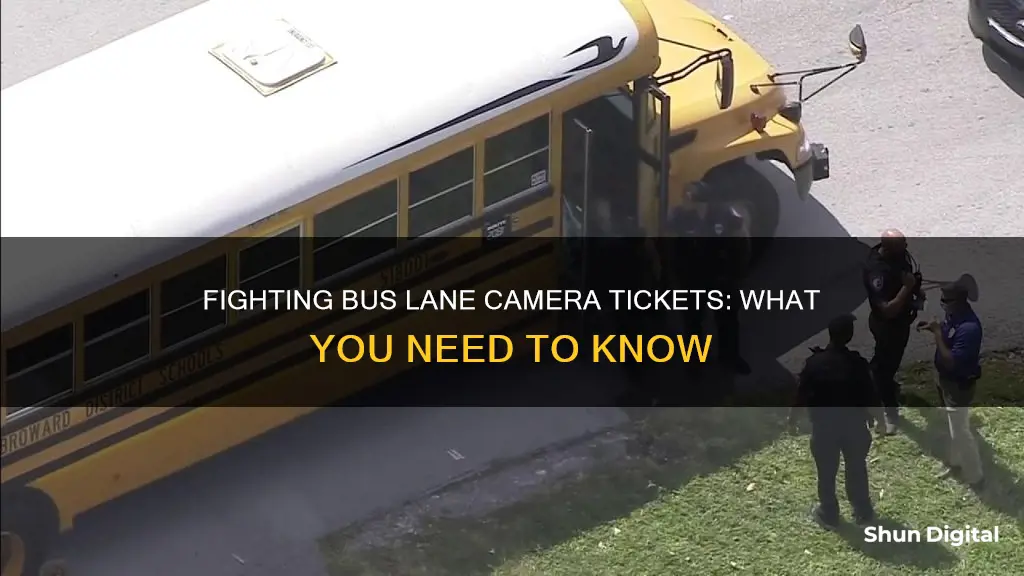
Bus lanes are always clearly marked, sometimes with dashed white lines, sometimes with solid white lines, and sometimes they're a different colour to the rest of the road surface. Driving in a bus lane by mistake is a common occurrence, and many councils now use CCTV to monitor their bus lanes. If you're caught driving in a bus lane, you'll be sent a penalty charge notice (PCN) through the post. The PCN will include details of your offence, information about your vehicle, and photographic evidence.
If you think you've been wrongly penalised, you can appeal your bus lane PCN. If your appeal is rejected, you could try appealing to an independent tribunal, but you'll have to do this within 28 days of receiving your notice of rejection letter.
| Characteristics | Values |
|---|---|
| How long do you have to appeal? | Usually 28 days |
| How long do you have to pay the fine? | 28 days |
| How much is the fine? | £90, reduced to £45 if paid within 14 days |
| How much is the fine in London? | £160, reduced to £80 if paid within 14 days |
| How much is the fine outside of London? | £65, reduced to £30 if paid within 14 days |
| What happens if you don't pay the fine? | The council will send a 'Notice to Owner' and increase the penalty by 50% |
| What happens if you don't pay after that? | The council will send a 'Charge Certificate' and increase the penalty further |
| What happens if you still don't pay? | The council can register the debt with the court and collect the charge using sheriff officers |
| Do you get points on your license? | No |
| Does it affect your car insurance premium? | No |
| What are valid reasons for driving in a bus lane? | To make a left turn, to enter a loading bay, to avoid an obstruction, to allow an ambulance to pass |
| What are valid reasons for appealing? | You received a penalty that's more than the relevant amount, you got a PCN when you'd already received a Fixed Penalty Notice, you're not the owner or hirer of the car, the car was being used without your consent |
What You'll Learn

You were not the owner of the vehicle when it was driven in the bus lane
If you were not the owner of the vehicle when it was driven in the bus lane, you can appeal the ticket. You will need to provide proof that you were not the owner, such as a receipt and a copy of the DVLA registration form. The process for appealing a bus lane ticket varies depending on your location, but generally, you will need to contact the local council or the authority that issued the ticket. In most cases, you must appeal within 28 days of receiving the ticket. If your appeal is rejected, you can take your case to an independent adjudicator or tribunal.
Discovering Your Camera Raw Version: A Guide
You may want to see also

The bus lane was not clearly marked with paint or signs
If you receive a bus lane camera ticket, one of the most common and effective ways to contest it is by arguing that the bus lane was not clearly marked or adequately indicated. Here are some detailed instructions on how to approach this defense strategy:
Firstly, thoroughly examine the bus lane in question and gather evidence. Take clear photographs or videos of the bus lane, focusing on any lack of clear markings or signage. Ensure that your evidence shows the entire length of the bus lane, including entry and exit points, as this will help demonstrate that the lane was not properly marked throughout. Look for faded paint, incomplete lines, or missing signs. Check the area for any obstructions that might have blocked your view of the bus lane markings, such as parked cars, trees, or other road furniture.
Secondly, research the specific regulations and guidelines for bus lane markings in your area. These regulations may be available on your local government or transportation authority's website. Familiarize yourself with the requirements for bus lane markings, including their color, width, and any mandatory accompanying signs. By understanding these regulations, you can pinpoint any deviations or inadequacies in the bus lane markings.
When constructing your argument, refer to the evidence you have gathered and the specific regulations. Highlight any discrepancies or failures to meet the standards. For example, if the regulations mandate a specific width for the bus lane markings and you can demonstrate that the actual markings are significantly narrower, this would support your case. Additionally, if there are regulations requiring certain signs to be posted at specific intervals along the bus lane, note any instances where these signs are missing or placed incorrectly.
In your defense, you should also consider including any witness statements from passengers in your vehicle or other individuals who may have been present. Their testimony can provide additional support for your claim that the bus lane was not clearly marked. Their perspective as observers can reinforce the argument that the bus lane markings were inadequate and failed to provide clear guidance to drivers.
Finally, when presenting your case, maintain a respectful yet firm tone. Clearly articulate your findings and how they violate the established regulations. Emphasize that you took reasonable care and attention while driving and that the inadequate markings directly contributed to the infraction. By presenting a well-structured, evidence-based argument, you stand a good chance of successfully contesting the bus lane camera ticket on the grounds that the bus lane was not clearly marked with paint or signs.
Camera Tickets: Ohio's Law and Your Rights
You may want to see also

The bus lane was time-sensitive and not active at the time of passing
If you've been ticketed by a bus lane camera, one possible defense is to argue that the bus lane was time-sensitive and not active at the time you passed through it. This strategy relies on understanding the specific rules and restrictions governing the bus lane in question and gathering evidence to support your claim. Here's a step-by-step guide to help you build your case:
Understand the Bus Lane Regulations: Different cities and regions have varying rules for bus lanes, including their operational hours. Study the local traffic laws or reach out to the local transportation authority to understand the regulations for the specific bus lane where you received the ticket. Identify the designated hours during which the bus lane restrictions apply.
Verify the Time of Infraction: Examine the ticket and supporting evidence provided by the camera operator. Look for a timestamp that indicates the exact time the infraction was captured. This timestamp will be crucial in your argument that the bus lane was not active at that specific time.
Gather Evidence of Your Passing Time: Collect evidence to establish the time you passed through the bus lane. This could include time-stamped photos, GPS data, witness statements, or even receipts from establishments near the bus lane that indicate the time you were in the area. Corroborating evidence that pinpoints your location and the time will strengthen your case.
Compare with the Bus Lane Active Hours: Compare the time of your passing with the designated active hours of the bus lane. If the bus lane is only operational during specific times of the day or certain days of the week, you may have a strong argument that it was inactive when you used it.
Present Your Case: Compile the evidence and construct a clear and concise argument that demonstrates the discrepancy between your passing time and the bus lane's active hours. Submit this information along with any necessary forms or statements when contesting the ticket. Be thorough in your explanation, providing references to the specific regulations and highlighting the timestamped evidence.
Remember to act promptly upon receiving the ticket, as there may be time limits for submitting your challenge. Ensure that your argument is honest and based on factual evidence. By following these steps, you can effectively argue that the bus lane was time-sensitive and not active at the time of your passing, potentially resulting in a dismissed ticket.
The Evolution of HD Cameras: A Historical Perspective
You may want to see also

You were making way for an emergency vehicle
If you've received a bus lane ticket, you can make a representation or appeal to have it cancelled. The specific process depends on your location.
In the UK, you can make a representation or appeal online or by post. If your representation is refused, you can appeal to an independent adjudicator. You must generally do this within 28 days of receiving your "notice of rejection" letter.
In the US, you have the right to dispute a bus lane ticket. Possible defences include:
- Some condition on the roadway prevented you from making an immediate right turn.
- The conditions on the roadway left you with no other option but to enter and stay in the bus lane.
- You were complying with the direction of law enforcement personnel.
- You have evidence of a sudden mechanical breakdown or unexpected medical emergency that necessitated your parking in the bus lane.
- You have evidence of temporarily stopping to expeditiously pick up or drop off passengers at the curbside.
If you received a bus lane ticket for making way for an emergency vehicle, you can use the above defences, depending on your location. You can argue that you had to enter the bus lane to avoid an obstruction or to allow an ambulance to pass. Many bus lanes are monitored by CCTV, so the authorities should be aware of the circumstances.
In the UK, rule 141 of the Highway Code states that you should not drive in a bus lane during its period of operation unless you are stopping, loading, or unloading where this is not prohibited. However, there are exceptions to this rule. For example, Nottingham City Council advises that it is acceptable to drive in a bus lane during its operating times when directed to do so by a police officer in uniform, to avoid a collision or debris in the road, to drop off or pick up a passenger, due to circumstances outside the control of the driver, or to enter or exit a driveway to a roadside property.
Updating Camera Raw in Lightroom: Offline Method
You may want to see also

You were avoiding an obstruction
When challenging a bus lane camera ticket on the grounds of avoiding an obstruction, it is important to understand the specific circumstances that could strengthen your case. Firstly, identify the exact nature of the obstruction and gather any available evidence. This could include photographs or videos showing the obstruction and its impact on the flow of traffic. If possible, document the dimensions of the obstruction, its location in relation to the bus lane, and any relevant details that might support your claim. For example, if a large fallen tree branch blocked a significant portion of the road, forcing you to veer into the bus lane to avoid a collision, detailed measurements and images of the branch's size and position would be beneficial.
Additionally, witness statements can provide valuable corroborating evidence. If there were passengers in your vehicle or other individuals nearby who observed the obstruction and your subsequent maneuver into the bus lane, their testimony could support your argument. Obtain written statements from these witnesses that describe their observations, including details such as the date, time, location, and specific details about the obstruction. The more specific and detailed the witness statements are, the more credible and persuasive they become as evidence.
It is also worth considering the timing and duration of your presence in the bus lane. If you can demonstrate that you entered the bus lane only for as long as it took to safely navigate past the obstruction, it could suggest that your primary intention was not to bypass traffic or break the rules, but rather to ensure the safety of your vehicle and those around you. Any available evidence, such as dashcam footage or even GPS data, that can corroborate your brief presence in the bus lane would be advantageous.
When building your case, it is important to review the applicable road regulations and traffic laws. Familiarize yourself with the specific rules governing the use of bus lanes in your area, as well as any exceptions or provisions that might apply in cases of obstructions or emergencies. Understanding the legal framework will enable you to present your case more effectively and potentially identify any loopholes or technicalities that could work in your favor.
Lastly, when challenging the ticket, it is advisable to maintain a respectful and professional tone. While you may feel frustrated or wronged by the situation, presenting your case calmly and logically will reflect well on you. Clearly and concisely explain the circumstances, highlighting the presence of the obstruction and the steps you took to safely navigate the situation. By providing a detailed and well-supported account, you increase the chances of successfully disputing the bus lane camera ticket on the grounds of avoiding an obstruction.
Exporting from AE: Camera Raw Controls Explained
You may want to see also
Frequently asked questions
The first step is to appeal to the local council that issued the ticket. If the council rejects your appeal, you can then appeal to an independent tribunal, such as the Traffic Penalty Tribunal or the General Regulatory Chamber.
There are several valid reasons for appealing a bus lane camera ticket. These include:
- The bus lane was not clearly marked.
- The bus lane was time-sensitive and not active at the time of the offence.
- You did not own the vehicle at the time of the offence.
- The vehicle was being driven without your consent.
- You were making way for an emergency vehicle.
- You were avoiding an obstruction in your lane.
If you don't pay or successfully appeal the ticket, the local council can increase the penalty by 50% of the original amount. They can also register the debt with the court and collect the charge using sheriff officers.


